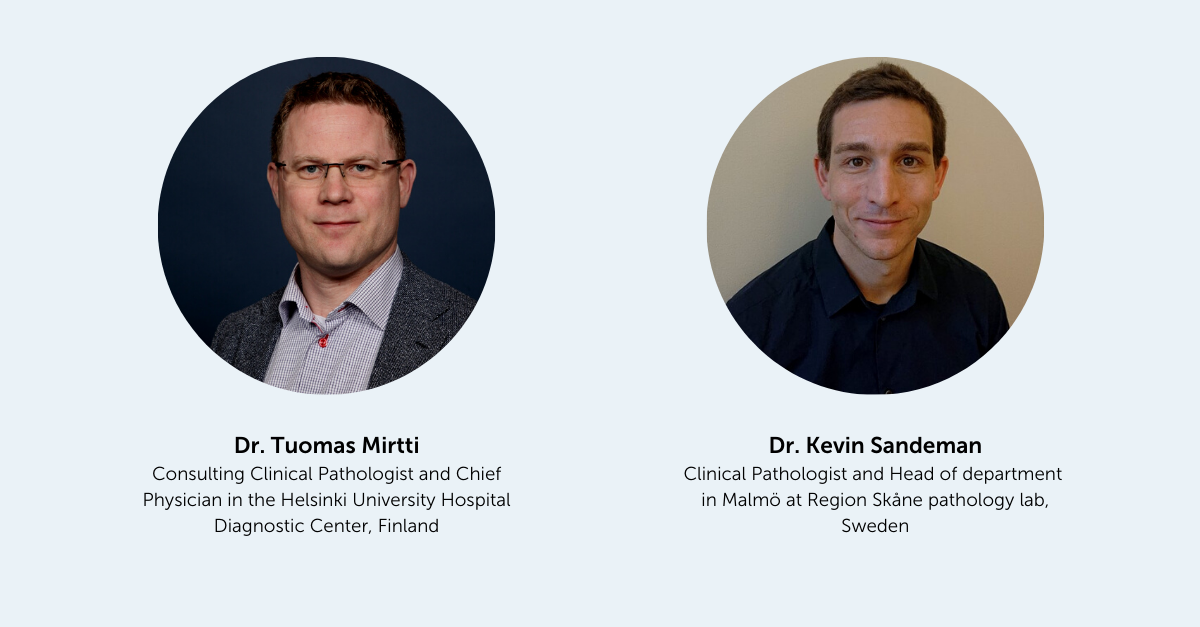
Pathologists have been examining glass slides under a microscope for over 150 years. Only recently did laboratories around the world start digitizing their slides, enabling more efficient workflows and increased accuracy in diagnostics. Adding AI to the newly digitized practice has the potential to increase these benefits exponentially. In this interview pathologists from Sweden and Finland share their experiences and thoughts on the impact of digital pathology and artificial intelligence in the clinical lab.
What are the benefits of digital pathology to a clinical lab?
Dr. Sandeman: There are many benefits: faster diagnostics, more efficient group consultation that can be done remotely, management has an overview of the pathology lab’s workflow, training of residents is more fluent and specialists have an overview of all the cases.
We saw a reduction in time to diagnosis for the pathologists of almost 28 % from 2018 to 2020 after the implementation of digital pathology in 2019. After digitizing the workflows, the need and cost for overtime made by the pathologists disappeared.
Adding AI to the digitized clinical workflow, what do you think are the biggest benefits of this to the pathologist?
Dr. Mirtti: Harnessing image analysis and AI-based algorithms to preanalytical (prediagnostic) quality control and to routine tasks like counting mitoses, counting stained cells or nuclei is something that partially already exists. In the next phase, AI could help in screening areas of interest and to highlight changes that deviate from normal histology. These kinds of routine tasks and screening for important areas in the tissue slides are what liberates the pathologists to execute more complex decisions and to develop diagnostics further.
Dr. Sandeman: Benefits for the pathologist include screening and prioritization. We can prioritize the findings on a slide in an order that will benefit the patients. A specific example is using AI for prostate cancer screening of needle biopsies. So we could use an algorithm to screen, and the AI system could prioritize the patient with the most aggressive cancer. We could therefore move that case to the front of the line allowing the pathologist to perform a diagnosis faster. Benefiting patients with dangerous diseases through faster answering times.
In terms of time savings from case prioritization, for example with prostate cancer diagnosis, when I work with prostate specimens and I receive 16 slides and somewhere within these slides is a tumor that can take up less than 2% of space on all the slides combined. This takes vigilance to find it. Therefore if the AI system can take that 2% area and present it to me to review at first then the diagnosis is much faster. This benefits my productivity.
The quality part is also important. AI can offer us standardization. We, pathologists, know that eyeballing is a good strategy, and performed well by really experienced pathologists. Eyeballing is an estimation done by just looking at the image, before quantitative analysis. AI can be better than the pathologist which means that grading or quantification tasks can be more standardized, producing less variation. You can also use AI after the screening and analysis for quality control, to check the results of the pathologists once more.
What is the benefit of AI to the healthcare system as a whole?
Dr. Mirtti: To the healthcare system in general, integrating multiple data modalities will become more and more important in diagnostics and treatment decisions, especially if we think about personalized care. In this AI could perhaps solve questions and suggest decisions that human experts can utilize in their educated decision-making.
Dr. Sandeman: Adding on to what Dr. Mirtti said, involving AI in the digitized clinical workflow would enable us to deliver more information with our results and reports, supporting the clinicians with more data.
Thinking of cancer diagnostics specifically, how do you think AI can provide an added benefit in this area?
Dr. Mirtti: As said earlier, taking care of certain routine tasks in different image based diagnostics is one area that we may be able to use AI solutions. Also, integrating the large amount of data in different modalities that is available in hospital data lakes and different kinds of data repositories might be better utilized with AI-based algorithms. More precise diagnostics and care for an individual patient is the goal that will also be economically beneficial.
Can you tell us about your current work on developing an AI model with Aiforia for prostate cancer diagnostics?
Dr. Mirtti: Well, it has been an intriguing task to learn about the possibilities of AI in cancer detection and grading. We, together with my colleague, spent a fair amount of time in annotating the so-called ground truth of prostate cancer grading. In this project we have been able to nicely combine the expertise of people working in different areas. Our aim is to develop something that is truly beneficial to clinical pathology in the long run.
How is the AI model performing compared to using traditional methods?
Dr. Mirtti: We are just about to publish our final results and what I can tell you now is that our AI model, built with the Aiforia Platform, is performing in cancer detection and classification on the level that we can be satisfied with and what can be brought into further clinical validation. We hopefully can show you some added benefits in the publication and develop the model even more in the future.